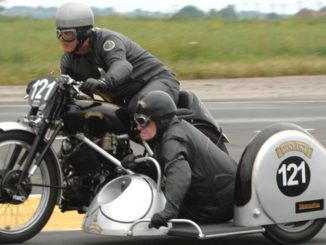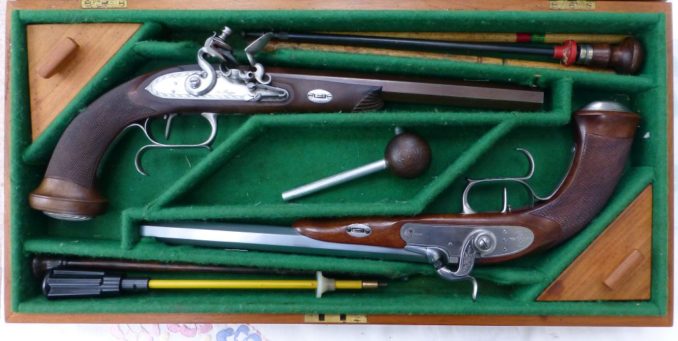
Some weeks ago, and quite by chance, a friend offered to sell me a rare mid-19th century rifle, the design of which I had long found to be of interest. Although I was not at that time looking to add to my collection I knew that if I passed it by I might never have another opportunity to get to grips with one so naturally, and with Mrs P’s blessing, I bought it. Getting this strange old rifle back into use will be a challenge and should therefore be worthy of an article or two.
Rather than dive straight into this particular project though, I thought it would be more sensible to outline briefly the stage that firearms development had reached by the end of the 18th century and from there approach my topic in more or less chronological order.
For as long as I can remember, I have been interested in the evolution of firearms and in particular by their history and development during the 19th century, a period which saw enormous leaps forward in both industrial and technological innovation. I’m intrigued by the problems associated with particular types of weapons and by the attempts made to overcome them; which of these succeeded, which failed and why?
The firearms that we see in use today by the military, law enforcement agencies and sportsmen and women did not come about through a linear, logical and step-by-step progression. While a few of the more practical innovations ended up being adopted for general usage, by far the majority failed to be accepted or were rapidly superseded and as a result ended up on the scrapheap of history.
It is a fascinating story not only for those with a passion for guns and shooting but also for anyone with an interest in mainly Victorian history and the engineering and technology of the Industrial Revolution. Getting old and long obsolete pistols and rifles back into use is a challenge that involves a great deal of research, experimentation and patience but hands-on experience of using these museum pieces is without a doubt the best way to understand how they were used, and to what effect, in battle, in the field and on the target range. In the process, long-forgotten yet once commonplace practices and procedures must be rediscovered largely by trial and error as by no means all were contemporaneously documented. One thing I can guarantee from personal experience is that while shooting these ancient weapons can be frustrating, it is always a whole lot of fun.
In these articles I will trace some of the more significant advances in firearms technology made in a century during which we progressed from single-shot and mainly smoothbore flintlocks to repeating rifled weapons capable of amazing accuracy at prodigious distances. To illustrate this, I shall be looking in detail at pistols and rifles in my own modest collection supplemented where appropriate with others owned by my shooting friends. Specifically, I shall be answering such practical questions as, how do they work and what are they like to use?
The first 500 years
No one knows for certain where, when or by whom the first guns were invented but the consensus seems to be that gunpowder originated in China sometime during the 13th century. Written and archaeological sources show that primitive cannon and ‘handgonnes’ were certainly in use in Europe by the 14th century with cannon first being used in battle at Crécy in 1346. These early weapons were not all that effective but they must nevertheless have had a terrifying psychological impact on the enemy in an age of superstition and ignorance.
At its most basic, a gun is simply a metal tube open at one end, the ‘muzzle’, and sealed at the other end, the ‘breech’. In the early days, before methods of casting or forging these metal tubes had been perfected, they were made up of staves of flat iron laid longitudinally around a cylindrical timber former and held together with metal bands heat shrunk to fit around them. Due to this method of construction these gun tubes inevitably became known as ‘barrels,’ a term that persists to this day.
To load a gun, a measured charge of gunpowder (a mixture of saltpetre, sulfur and charcoal) is put into the breech, usually via the muzzle; a projectile originally made of stone and later of cast iron or lead is then rammed on top of the powder followed by some sort of wadding to hold everything in place until the time comes to fire it. But once loaded, how do you ignite the gunpowder charge? At the breech end a narrow communication channel known as a ‘vent’ or ‘touch hole’ drilled through the barrel wall gives access to the powder charge inside. This channel and a small depression on the top of the barrel can be filled with fine (and hence fast-burning) ‘priming’ powder and lit with a glowing taper or burning match cord; alternatively a length of fuse can be inserted and ignited, much like lighting the blue paper on a firework.
This is all well and good on large cannon supported on some form of carriage but problems arise when trying to do this with a hand-held weapon. The following picture shows the oldest known German handgonne, the Tannenbergbüchse, which was found loaded with a lead ball in the well of a castle that was destroyed in 1399 and which therefore must have been made prior to that date. Below it is the barrel of a typical English smoothbore pistol made around 1800. If you ignore the sights and wedge fittings on the latter, they are to all intents and purposes the same.
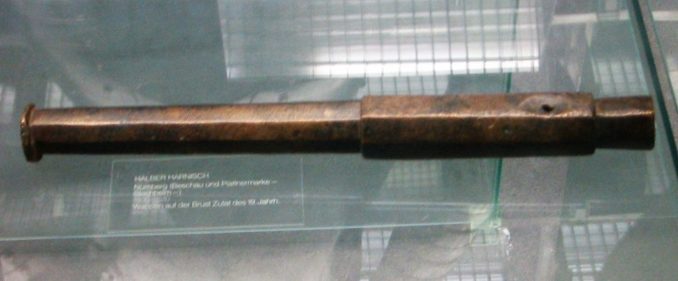

I don’t know about you but I wouldn’t like to try shooting one of those naked barrels without some means of holding it well away from my face and body while pointing it at my enemy and discharging it. The obvious thing to do would be to fix it to some sort of wooden handle so it could be held at arm’s length or be braced against the body or a wall – but once you do that you encounter another problem; how do you ignite the powder charge while keeping the weapon at arm’s length and pointed at the target?
Although this could be done rather clumsily by one man, early soldiers often overcame this difficulty by working in pairs, one to hold and point the gun while the other touched off the powder in the shallow depression on top of the barrel using a length of smouldering match cord fixed in a holder or ‘linstock’. While this undoubtedly worked, it was hardly satisfactory as a sudden gust of wind might blow the priming powder out of the touch hole reservoir; the powder might become damp in bad weather or the match cord could become extinguished at a critical point in the battle.
Clearly, what was needed was some sort of mechanism to allow the soldier or hunter to maintain his piece ready to fire unaided at a moment’s notice in all but the most inclement weather.
The initial solution to these problems was to move the touch hole from the top of the barrel to one side and to provide a small pan with a swivelling cover to both hold the priming power and keep it from blowing away while at the same time protecting it from the elements. By holding the smouldering match cord in the jaws of a snake-like curved arm or ‘serpentine’, it could be lowered into the uncovered priming powder by means of a lever thus setting off the main charge and firing the gun in a far more controlled manner.
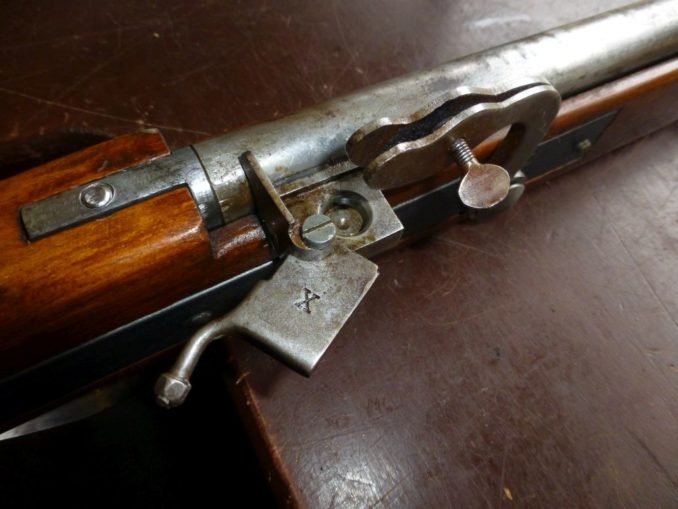
I must say that when I first tried shooting my friend’s reproduction matchlock musket I was very sceptical. The serpentine mechanism took a lot of getting used to as it is a simple pivot without spring assistance and consequently it feels very slow and agricultural in use. The shooter has to ensure that the end of the ‘match’, a burning length of sash cord that has been soaked in a saltpetre (potassium nitrate) solution and dried, is kept glowing by blowing on it and knocking off any accumulated ash. He also has to make sure that its end has been adjusted so as to enter the priming powder and for this purpose, as you can see, the top of the pan cover is marked with an index point in the form of a cross against which the tip of the match is carefully aligned in the closed position before firing.
When everything is ready, the weapon is pointed at the target (there are no sights so true aiming is not possible,) the pan cover is swivelled to expose the priming powder and the trigger is pulled back forcefully. At this point I was truly astonished as the ignition of the main charge was to all intents and purposes instantaneous, unlike later flintlocks I’ve used that often delay or ‘hang fire’. This delay is referred to as ‘lock time’ and the shorter the lock time the better for accurate shooting.
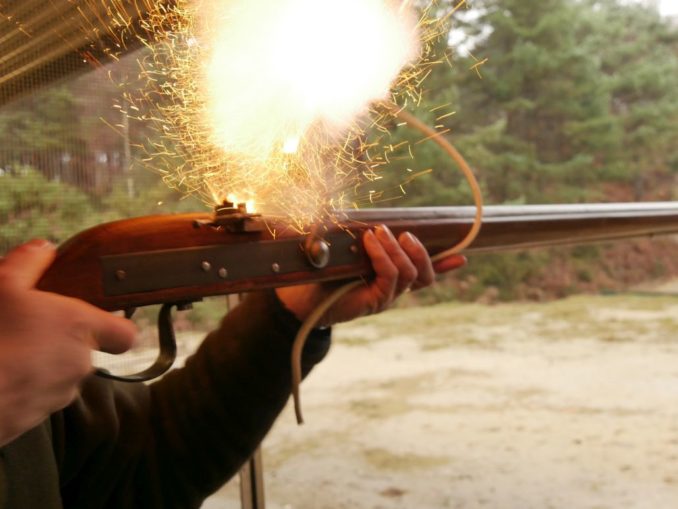
The next major development, the wheel lock, which reduced the lock time dramatically, was a step in the right direction but it was over-complicated and hence too expensive for common use. Here the ignition system works very much like that in an old-fashioned petrol cigarette lighter where a serrated steel wheel powered by a form of clockwork mechanism wound with a key spins rapidly against a piece of iron pyrites when the trigger is pulled, showering sparks into the priming pan and setting off the main charge.
The big breakthrough, however, came with the invention in the early 17th century of the flint or firelock. This was known by a variety of names such as ‘snaplock,’‘snaphaunce’, and ‘doglock’ and was a much simpler and thus cheaper yet reliable mechanism. Constantly refined over the years, the flintlock remained in use for more than two centuries before gradually being superseded by the cap lock in the 1830s. A discussion of the flintlock is therefore a convenient point at which to start our century of change.
By the beginning of the 19th century, the flintlock mechanism was at the peak of its development and in universal use in both military and sporting firearms but it was not without its problems and disadvantages. In the next article, we will look at the flintlock in some detail and consider what they are like to load and fire while discussing their advantages and shortcomings.
© text & images Tom Pudding 2019
Audio file


